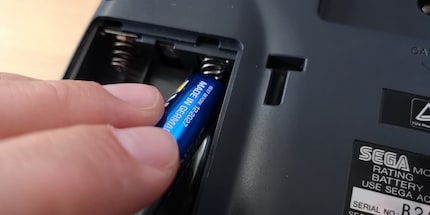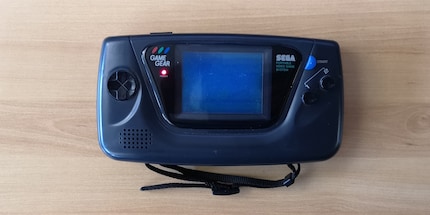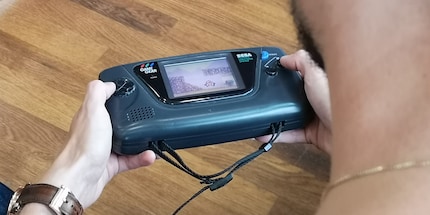
Game Gear: Old love pixelates after all
In the 90s, all my friends had a Game Boy. Only I didn't. In my eyes, I had the only true handheld: the Sega Game Gear. I spent many great hours with Sonic, Joe Musashi and Taz. Recently, I wanted to relive those times.
I'm nervous. I slowly climb the ladder into the attic of my father's house. I'm even sweating a little. That might be because it's 28 degrees on this day. A blazing heat radiates from the attic. But my heart is also racing because I want to retrieve my treasure from childhood days gone by. And it's possible that I won't find it at all. Perhaps it was dismantled into its individual parts years ago during electronic scrap recycling?
I'm talking about my Game Gear. The first portable games console from Sega, which was released in Japan in October 1990 and was intended to overtake the Game Boy: Colour display with backlight, capable of displaying 32 of 4096 colours simultaneously, a resolution of 160×144 pixels, 8 kB RAM and an additional 16 kB video RAM. Technically, the Game Gear was superior to the Game Boy, even though it was based on the Master System, which was four years older.
A small piece of video game history
Work on the device began in 1989 under the codename "Mercury". The Game Gear was officially announced at the Tokyo Game Show in June 1990 and three titles were available on release in the same year: "Columns", a kind of "Tetris", "Super Monaco GP" and "Pengo".
The Game Gear was a portable version of the Sega Master System with a lower resolution but more colours. In addition to the technological differences to the Game Boy, the Game Gear was deliberately designed in landscape format for better control.
Due to the great similarity to the Master System, most of the games for the portable version were ports of the stationary version. For games that were not ported, there was later a converter with which the Master System cartridges could be played on the Game Gear. Incidentally, the successor to the Game Gear, the Nomad, worked according to this principle. This was marketed as a portable Mega Drive, the successor to the Master System. However, special Nomad modules were not used here and those of the Master System were used from the outset. It was never released in Europe.
In Japan, the handheld sold below expectations. There are no reliable figures for the Land of the Rising Sun, but it is assumed that 1.25 million copies were sold by March 1994. In the States, things went somewhat better after a slow start. However, this was probably also due to the aggressive advertising campaign, as you can see in the video above this section. Nevertheless, Sega had to settle for second place behind Nintendo's Game Boy. By the end of 1993, four million units had been sold. In Europe, too, the Game Gear was only in second place behind Nintendo's handheld. In the following video you can see the European advert for the optional TV tuner.
Game Gear support was discontinued in 1997. Although the Game Gear always lagged behind the Game Boy in terms of sales figures, it was technically superior until the release of the Game Boy Advance in 2001. The Game Gear was not a great failure. With 11 million units sold worldwide and around 390 games, it did generate a modest profit for Sega.
The Game Boy was superior to the Game Gear in two respects. On the one hand, the Game Boy was slightly cheaper and offered far more games. On the other hand, the Game Gear was an unparalleled battery guzzler due to its colour display and backlight: It needed six AA batteries and lasted a maximum of five hours. I still remember buying a 24-pack of batteries before our holidays in Spain and they weren't even enough for the journey there and back.

My Precious
Which brings us back to the beginning. I've now arrived in the attic. It's chaos, but that's how it has to be in a junk room. In addition to the Game Gear, my NES should also be up here. I've stowed the two together. I should have no problem finding the larger Nintendo.
I let my gaze wander and recognise the NES after a few seconds. The Game Gear can't be far away, I've already spotted the first modules. A few seconds later, I'm holding my treasure in my hands. Now I just need to insert the batteries. Unfortunately, I no longer have the adapter. Years ago, I used it to cool my home entertainment system, which no longer exists. It would have been better if I hadn't, then I could start gaming straight away. So first I have to go and buy batteries, which I haven't done for a while - who needs them nowadays anyway?
The Game Gear is in front of me and I'm holding the batteries in my hands. But now I'm really nervous. Game Gears have a reputation for ageing badly. And the extreme temperature differences on the screed certainly haven't helped. After all, the screed is insulated for the sake of a start. I insert the batteries. I choose "Taz-Mania" as the game. It was such a pain in the arse back then, I want to relive it.

The second of truth. I flick the power switch. Great, the power LED lights up and the backlight also works. But then disappointment sets in. I can neither see a picture nor hear any sound. That's probably it. Resigned, I lower the Game Gear. Then I realise that, depending on the angle, I can still see a picture. I can't see anything from the front, but the more I tilt the handheld forwards, the more I recognise. So it's still running!

Ordering and waiting
A quick internet search shows me the reason for the initially disappointing result. As mentioned, game gears have a reputation for ageing badly. This is due to the capacitors used. They break quite quickly. I do some more research and come across YouTube tutorials. They explain in detail how to replace the capacitors. Now I'm convinced: I'll do the repair myself.
In addition to the tutorials, I also find various suppliers for spare parts. I order a Game Gear repair kit for 4.99 US dollars. This contains 20 capacitors and instructions. I also need a suitable screwdriver. Even back then, manufacturers were keen to ensure that customers didn't carry out repairs themselves. It costs me another insane 2.99 US dollars. Unfortunately, I may have to wait a little longer. The latest delivery date they give me is 2 September. And I was already nervous when I climbed the screed ladder.
From big data to big brother, Cyborgs to Sci-Fi. All aspects of technology and society fascinate me.
Interesting facts about products, behind-the-scenes looks at manufacturers and deep-dives on interesting people.
Show all